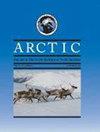An Ongoing Shift in Mammalian Nest Predators of Yellow-billed Loons in Arctic Alaska
IF 0.8
4区 地球科学
Q4 ENVIRONMENTAL SCIENCES
引用次数: 0
Abstract
The Coastal Plain of northern Alaska is an important nesting area for a variety of avian species, where the productivity of ground-nesting species can be strongly influenced by nest predators. Recently, the density of red foxes (Vulpes vulpes) has increased in many areas of the Arctic, likely because of climate warming as well as the availability of anthropogenic food sources during winter. In areas where they occur sympatrically, red foxes can outcompete and kill the smaller Arctic fox (Vulpes lagopus). There is considerable dietary overlap between the fox species, but if the red fox is a more successful nest predator, this ongoing shift in canid species could have important implications for ground-nesting species like the Yellow-billed Loon (Gavia adamsii). We examined time-lapse photographs from 186 nests of Yellow-billed Loons in northern Alaska during the years 2008 – 15 and 2019 for the presence of foxes and other nest predators and quantified nest predation by species. Although both Arctic and red foxes were photographed near nests, we found that all successful predation of Yellow-billed Loon nests by foxes was attributable to red foxes, which were the second most frequent predator of Yellow-billed Loon nests after Glaucous Gulls (Larus hyperboreus). Arctic foxes photographed at Yellow-billed Loon nests were unsuccessful at displacing incubating loons. Several data sources suggest that the prevalence of red foxes has increased in Arctic Alaska over the last three decades, a change that is likely to have negative impacts on the nesting success of Yellow-billed Loons and possibly other large waterbirds.阿拉斯加北极黄嘴潜鸟的哺乳动物巢穴捕食者正在发生变化
阿拉斯加北部的沿海平原是多种鸟类的重要筑巢区,在那里,地面筑巢物种的生产力可能受到巢穴捕食者的强烈影响。最近,在北极的许多地区,红狐(Vulpes Vulpes)的密度增加了,可能是因为气候变暖以及冬季人为食物来源的可用性。在它们共生的地区,红狐可以竞争并杀死较小的北极狐(Vulpes lagopus)。狐狸种类之间有相当多的饮食重叠,但如果红狐是更成功的巢穴捕食者,那么犬科动物物种的这种持续变化可能对黄嘴Loon (Gavia adamsii)等地面筑巢物种产生重要影响。我们检查了2008年至2015年和2019年期间阿拉斯加北部186个黄嘴潜鸟巢穴的延时照片,以了解狐狸和其他巢穴捕食者的存在,并按物种量化了巢穴捕食行为。虽然北极狐和红狐都在巢附近被拍摄到,但我们发现所有狐狸成功捕食黄嘴潜鸟的巢都归功于红狐,红狐是黄嘴潜鸟巢的第二大捕食者,仅次于白鸥(Larus hyperboreus)。北极狐在黄嘴潜鸟的巢中被拍到,它们没有成功地取代正在孵化的潜鸟。一些数据来源表明,在过去的三十年里,阿拉斯加北极地区红狐的数量有所增加,这一变化可能会对黄嘴潜鸟和其他大型水鸟的筑巢成功率产生负面影响。
本文章由计算机程序翻译,如有差异,请以英文原文为准。
求助全文
约1分钟内获得全文
求助全文
来源期刊

Arctic
地学-环境科学
CiteScore
2.30
自引率
0.00%
发文量
51
审稿时长
6-12 weeks
期刊介绍:
Arctic is a peer-reviewed, primary research journal that publishes the results of scientific research
from all areas of Arctic scholarship. Original scholarly papers in the physical, social, and biological
sciences, humanities, engineering, and technology are included, as are book reviews,
commentaries, letters to the editor, and profiles of significant people, places, or events of northern
interest
 求助内容:
求助内容: 应助结果提醒方式:
应助结果提醒方式:


